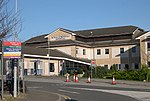Carrine Common & Penwethers
Cornwall geography stubsEnglish Site of Special Scientific Interest stubsSites of Special Scientific Interest in CornwallSites of Special Scientific Interest notified in 1973Special Areas of Conservation in Cornwall

Carrine Common & Penwethers is a Site of Special Scientific Interest (SSSI) in Cornwall, England, UK, noted for its biological characteristics. The 46-hectare (110-acre) site is located at the settlement of Penweathers, within the civil parish of Kea, half a mile south of the city of Truro.'Carrine Common' is also designated a Special Area of Conservation.
Excerpt from the Wikipedia article Carrine Common & Penwethers (License: CC BY-SA 3.0, Authors, Images).Carrine Common & Penwethers
Truro Kea
Geographical coordinates (GPS) Address Nearby Places Show on map
Geographical coordinates (GPS)
| Latitude | Longitude |
|---|---|
| N 50.2514 ° | E -5.0894 ° |
Address
TR3 6EA Truro, Kea
England, United Kingdom
Open on Google Maps








